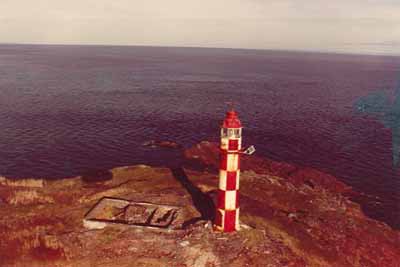Lighttower
Recognized Federal Heritage Building
Random Head, Newfoundland and Labrador

Aerial view
(© Canadian Coast Guard, 1989)
Address :
Random Head, Newfoundland and Labrador
Recognition Statute:
Treasury Board Policy on Management of Real Property
Designation Date:
1990-10-22
Dates:
-
1894 to 1894
(Construction)
Event, Person, Organization:
Other Name(s):
-
Random Head Lighthouse
(Other Name)
Custodian:
Fisheries and Oceans Canada
FHBRO Report Reference:
89-211
DFRP Number:
01068 00
Description of Historic Place
The Lighttower at Random Head, is a modest, cast-iron tower with a red and white checkerboard paint scheme. Its profile is accentuated by the lantern capped with a prominent weathervane. The Lighttower is located on the summit of the largest island in the Motion Islands, a remote, sparsely populated section of Trinity Bay. The designation is confined to the footprint of the building.
Heritage Value
The Lighttower, is a Recognized Federal Heritage Building because of its historical associations, and its architectural and environmental value.
Historical Value
The Lighttower illustrates the theme of navigational aids in Newfoundland when it was a British colony with an economy based almost solely on the sea. Its construction also illustrates the theme of growing industrialization around the turn of the 20th century.
Architectural Value
The Lighttower is a very good example of a utilitarian structure constructed with cast-iron technology to an excellent functional design. It is one of approximately 26 lighthouses of prefabricated iron and steel construction, thought to be the only surviving examples of their type in Canada. Favoured because of their inexpensive cost, ease of erection, low maintenance requirements and long-term durability, these structures reflect the desire to achieve a design that would withstand the rigours of the Newfoundland coast.
Environmental Value
The Lighttower reinforces the character of its maritime setting and is a familiar landmark to mariners in the region.
Sources:
Joan Mattie, Six Newfoundland Lighthouse,: Green point; Heart’s Content; King’s Cove Head; Little Denier Island; North Head; Brigus; Random Head, Newfoundland, Federal Heritage Building Review Office Building Report 89-198, 89-199, 89-200, 89-201, 89-208, 89-211; Lighthouse: Random Head, Conception Bay, Brigus, Newfoundland, Heritage Character Statement, 89-211.
Character-Defining Elements
The character-defining elements of the Lighttower should be respected.
Its utilitarian design, cast-iron construction technology and construction, for example: the simple, well-proportioned massing of the tower which consists of a smooth tubular form composed of a shaft, lantern platform and lantern capped with a prominent weathervane; the cast-iron construction system, comprised of cylindrical segments bolted together on the interior face; the red and white checkerboard paint scheme.
The manner in which the Lighttower reinforces the character of its maritime setting and is a familiar landmark, as evidenced by: its overall composition and appearance situated at the summit of a remote island on the rugged, exposed Newfoundland coast; its high visibility to passing sea going vessels.
Heritage Character Statement
Disclaimer -
The heritage character statement was developed by FHBRO to explain the reasons for the designation of a federal heritage building and what it is about the building that makes it significant (the heritage character). It is a key reference document for anyone involved in planning interventions to federal heritage buildings and is used by FHBRO in their review of interventions.
The lighthouse at Random Head was built in 1894 under the direction of J.T. Nevill, Inspector of Lighthouses from 1871 to 1895. Although the structure was manufactured in Britain, or assembled from parts ordered from a catalogue, there is increasing evidence to suggest that Nevill functioned as overall designer. Transport Canada, the Canadian Coast Guard, is the custodian. See FHBRO Building Report 89-211.
Reasons for Designation
The Random Head Lighthouse was designated Recognized for its aesthetic and functional design, its historical associations, and its landmark qualities.
Well-proportioned and sparsely detailed, the lighthouse is important as a modest, but intact example of cast-iron construction technology. This light is one of about 26 lighthouses of prefabricated iron and steel construction, thought to be the only remaining examples of their type in Canada. Favoured because of their inexpensive cost, ease of erection, low maintenance requirements and long-term durability, these structures reflect the growing industrialization at the turn of the century, and the desire to achieve a design that would withstand the rigours of the Newfoundland coast.
The lighthouse, and the system of which it is a part, illustrate the theme of navigational aids in Newfoundland when it was a British colony with an economy almost totally oriented toward the sea.
Located on the summit of the largest island in the Motion Islands, a remote, sparsely populated section of Trinity Bay, the lighthouse admirably fulfils its role as a landmark on a rugged, isolated site.
Character Defining Features
The heritage character of this lighthouse resides in its form, materials, construction details and setting.
The utilitarian character of the tower is reflected in its smooth tubular form and lack of decoration. Its construction system, comprised of rounded rectangular segments bolted together on the interior face, should be respected, and repairs executed in like materials, or materials closely matched on the galvanic scale, to avoid galvanic corrosion.
The base of the tower should be kept clear of vegetation and decaying matter, and a sound protective paint layer must be maintained. Regular inspection and maintenance, and consultation with a metals conservator, are recommended.
Alterations which might affect the structure's profile should be resisted.
The lantern and cap, with its prominent weathervane, is a focal point of the composition and should be preserved without alteration. The red and white checkerboard paint scheme is tied to the tower's function and contributes to its visual interest, and must be maintained.
The rugged, exposed nature of the site contributes to the lighthouse's heritage character and landmark status. The sparse, utilitarian character of the site should be protected. The foundation ruins of the former 1894 house remain, and should be stabilized and retained for future investigation. Any evidence of the trolley tracks that brought supplies from the landing to the lighthouse should also be located and protected.